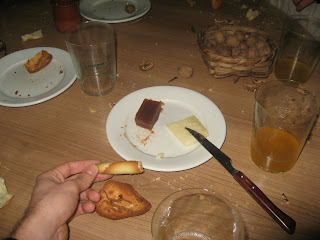I was invited with some Spanish friends to go to San Sebastian for the weekend. Our plan was to go out for dinner in a 'sidreria', or cider house, in a small town nearby. Cider houses are typical in that region of Spain (and also Asturias).

Here's a picture of a few of us standing on a pier in beautiful San Sebastian.

Here's the majority of us standing on a little mountain top overlooking the bay of San Sebastian at nightfall.


The small town, or village, we visited was called Astigarraga. It's a place that's famous for its cider houses; and it has many. We visited a traditional one where the food is served to you on big plates and we all share. It's also custom to eat standing up, something that might be annoying to some people, but not to me. I'll explain why.
The first plates served were that of 'chorizo a la sidra', which is Spanish sausage cooked in cider, and then 'tortilla de bacalao', which is a Spanish omelette made with cod. Both of those plates were fantastic.

The third plate you see above is another serving of cod with fried green peppers, or 'bacalao con pimientos verdes'. We ate everything with bread.
Do you drink anything else besides cider in a cider house? I think you can, but I wouldn't recommend it. You get all the cider you can drink. In the restaurant we went to there were giant casks or kegs or containers of cider, and there were waiters or assistants who would open up these containers and let cider squirk out in long smooth sprays. The idea then is to catch the cider in your glass, but just a little. This fresh super tasty type of cider is best drank immediately after served, which means you just fill your glass up a little bit and either drink it immediately and get another one, or bring it back to your table and drink it very soon after.
That's why I didn't mind standing up all the time, because I was always going back for more cider. Ha! Check out the video below showing you how it works. It's so much fun! I'd recommend this to anyone!


The next plate was a very tender meat called 'chuleton', or ... big meat slab. I don't really know how to translate this one. It's a really tender cut of meat that looks a little like a tenderloin. It's served quite rare, which makes it chewy, juicy, and extremely flavorful!

Last we were served dessert. There are a couple things here. In front, and in my hand, are two typical desserts made from almond, which is typical of the north of Spain. The flat brown cookie-looking dessert is called a 'teja', which is literally a roof tile, which I suppose it resembles. On the flat and in the basket in the background is a combination dessert that you put together. Those are walnuts that you must crack and then put over the combo of a really good Basque cheese and 'membrillo', which is quince jelly.
One of the best meals I've had in Spain. Definitely check out these 'sidrerias' if you make it to the north of Spain. The best ones are in Asturias and Pais Vasco.
 They all dressed up as geishas, which was a nice coincidence since the only costume I had that I wanted to wear was that of my Japanese man (the same costume I wore to celebrate Halloween). My roommate if you're wondering is the one to the left of me; her name is Alicia.
They all dressed up as geishas, which was a nice coincidence since the only costume I had that I wanted to wear was that of my Japanese man (the same costume I wore to celebrate Halloween). My roommate if you're wondering is the one to the left of me; her name is Alicia.  We went out to the famous Laurel street for pinchos and met lots of other people dressed up in costumes. It's really a shame that we in the States don't celebrate Carnival like the rest of the world, because it's really a good-humored fun holiday.
We went out to the famous Laurel street for pinchos and met lots of other people dressed up in costumes. It's really a shame that we in the States don't celebrate Carnival like the rest of the world, because it's really a good-humored fun holiday.  This was an interesting scene. This guy was dressed up as Superman in a cage. His friends were feeding him through the bars. At least he had a chair...
This was an interesting scene. This guy was dressed up as Superman in a cage. His friends were feeding him through the bars. At least he had a chair...
























